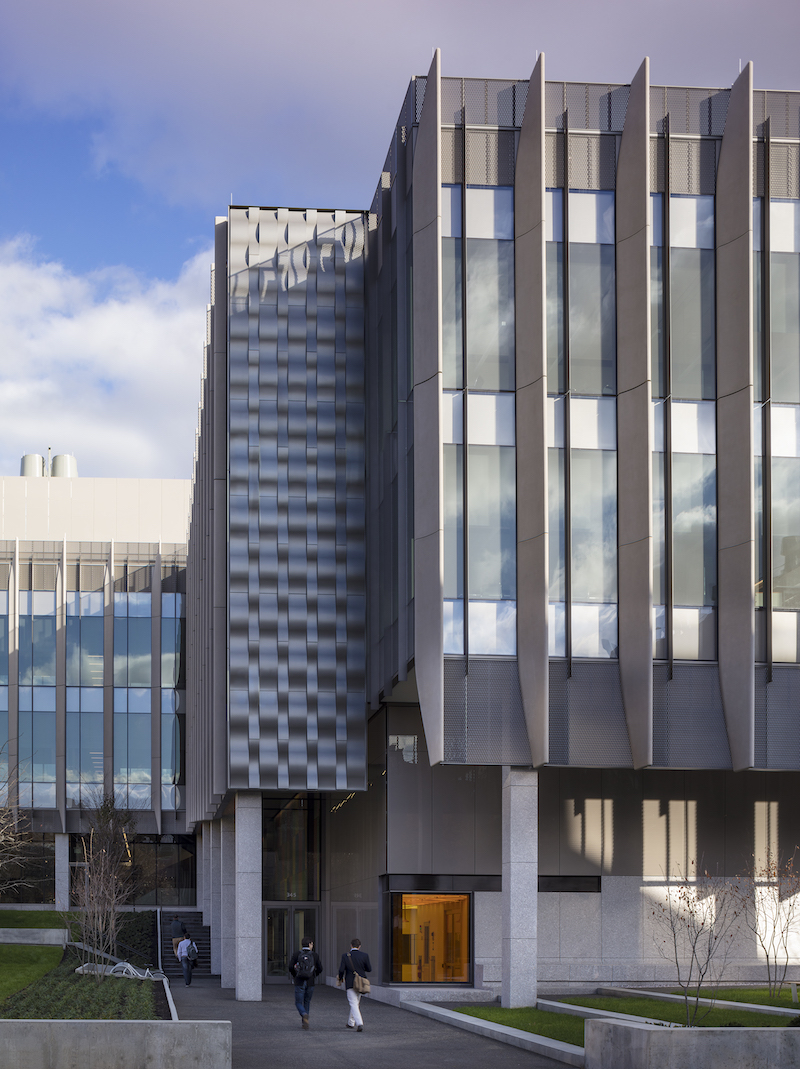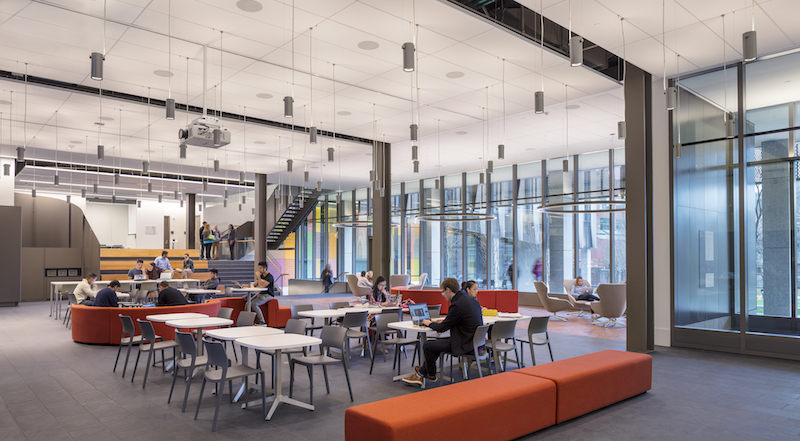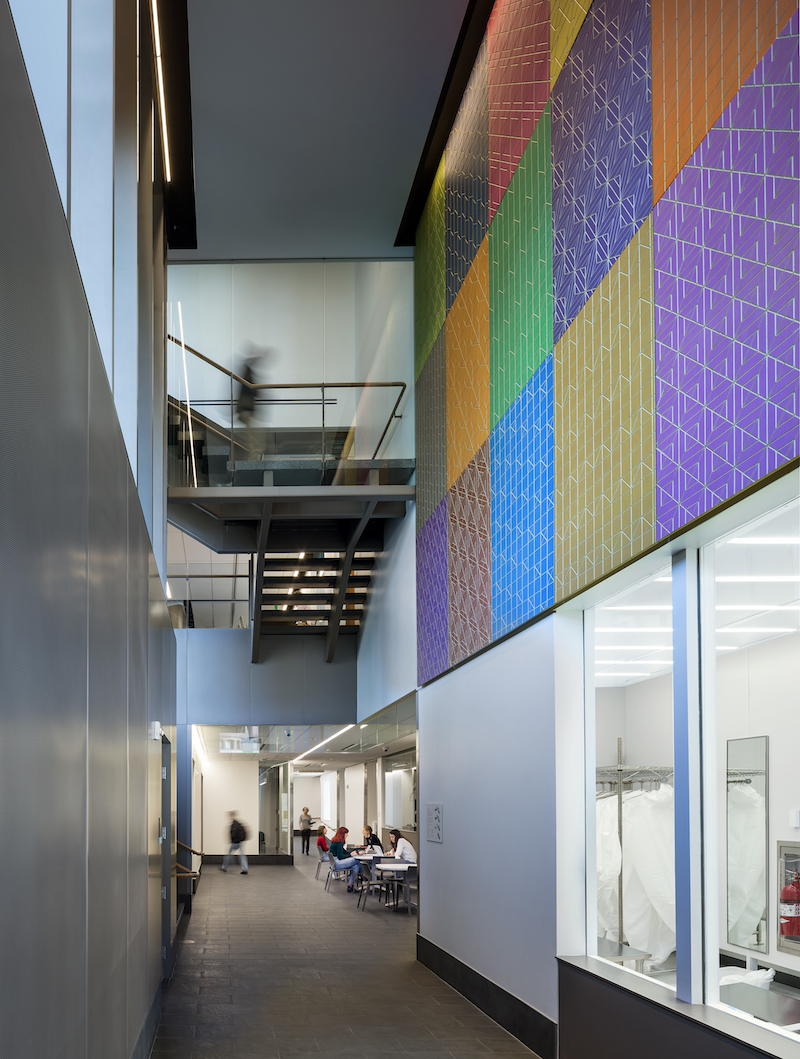The recently completed Engineering Research Center (ERC) at Brown University provides the school with 80,000 sf of space across three-floors. The building houses specialized research facilities for nanomaterials, photonics, and environmental science to help expand research in renewable energy and advanced materials.
Among the new $88-million facility’s spaces are an 8,000-sf cleanroom for nanomaterials, microelectronics, and photonics, an imaging suite, a bioimaging suite, 22 open-plan research labs, 116 dedicated workstations for graduate students, 20 lab modules, 10 conference/meeting spaces, and a café.
 Photo: Warren Jagger Photography.
Photo: Warren Jagger Photography.
Also included are the Hazeltine Commons on the building’s first floor and Giancarlo Plaza, a green space outside the building’s front doors. These two spaces are designed to create an “intellectual community” for faculty and students from across the campus.
The ERC is is tracking LEED Gold Certification with an energy and performance goal of 25% better than minimum efficiency and performance criteria established in the Rhode Island-adopted International Energy Conservation Code. Among the building’s sustainable features are 60 glass reinforced concrete vertical fins to manage solar gain, four water-filling stations, and a façade made from 40% glass to capture natural daylight and lower energy costs.
 Photo: Warren Jagger Photography.
Photo: Warren Jagger Photography.
Shawmut Design and Construction used Integrated Project Delivery and Lean Construction delivery methods to finish the building months ahead of schedule. This is the first time a Brown University building was completed using these methods.
See Also: Virginia Commonwealth has at least three major expansion projects under construction
 Photo: Warren Jagger Photography.
Photo: Warren Jagger Photography.
 Photo: Warren Jagger Photography.
Photo: Warren Jagger Photography.
Related Stories
| Aug 11, 2010
Living and Learning Center, Massachusetts College of Pharmacy & Health Sciences
From its humble beginnings as a tiny pharmaceutical college founded by 14 Boston pharmacists, the Massachusetts College of Pharmacy & Health Sciences has grown to become the largest school of its kind in the U.S. For more than 175 years, MCPHS operated solely in Boston, on a quaint, 2,500-student campus in the heart of the city's famed Longwood Medical and Academic Area.
| Aug 11, 2010
Giants 300 University Report
University construction spending is 13% higher than a year ago—mostly for residence halls and infrastructure on public campuses—and is expected to slip less than 5% over the next two years. However, the value of starts dropped about 10% in recent months and will not return to the 2007–08 peak for about two years.
| Aug 11, 2010
Team Tames Impossible Site
Rensselaer Polytechnic Institute, the nation's oldest technology university, has long prided itself on its state-of-the-art design and engineering curriculum. Several years ago, to call attention to its equally estimable media and performing arts programs, RPI commissioned British architect Sir Nicholas Grimshaw to design the Curtis R.
| Aug 11, 2010
Setting the Green Standard For Community Colleges
“Ohlone College Newark Campus Is the Greenest College in the World!” That bold statement was the official tagline of the festivities surrounding the August 2008 grand opening of Ohlone College's LEED Platinum Newark (Calif.) Center for Health Sciences and Technology. The 130,000-sf, $58 million community college facility stacks up against some of the greenest college buildings in th...
| Aug 11, 2010
University of Arizona College of Medicine
The hope was that a complete restoration and modernization would bring life back to three neoclassic beauties that formerly served as Phoenix Union High School—but time had not treated them kindly. Built in 1911, one year before Arizona became the country's 48th state, the historic high school buildings endured nearly a century of wear and tear and suffered major water damage and years of...
| Aug 11, 2010
Cronkite Communication School Speaks to Phoenix Redevelopment
The city of Phoenix has sprawling suburbs, but its outward expansion caused the downtown core to stagnate—a problem not uncommon to other major metropolitan areas. Reviving the city became a hotbed issue for Mayor Phil Gordon, who envisioned a vibrant downtown that offered opportunities for living, working, learning, and playing.







